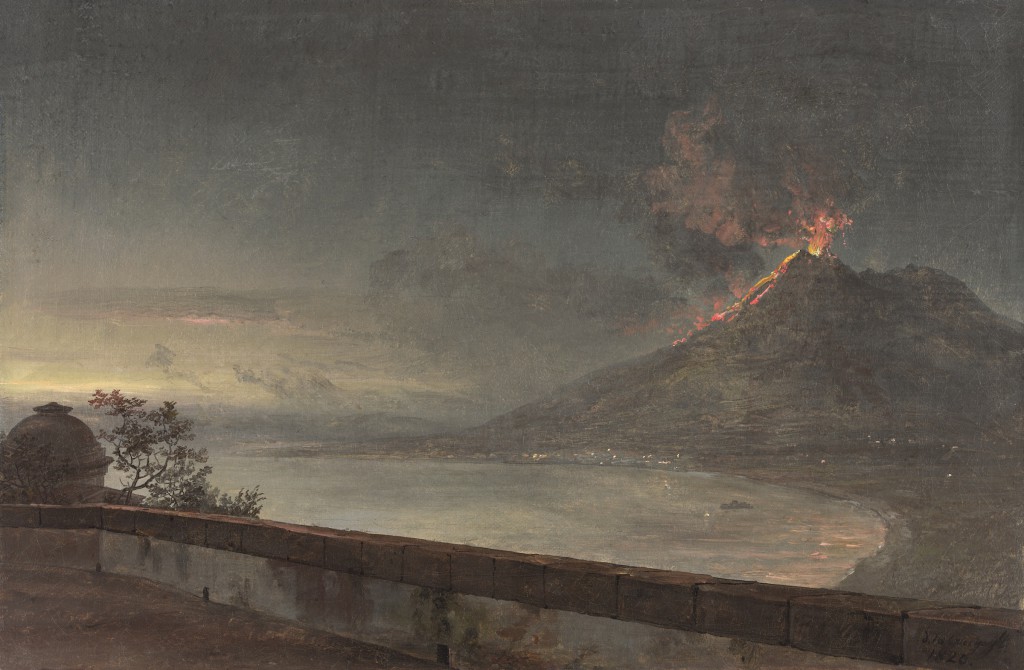Johan Christian Dahl, called Clausen-Dahl (Bergen 1788 - 1857 Dresden)
Mount Vesuvius and the Gulf of Naples, seen from the Terrace of the Villa Quisisana, 1820
Oil on canvas
Dated lower right d. 16 August 1820
SOLD / VERKAUFT
Provenance:
Gerenal A. Bull
Oswald Berentzen, Oslo, 1920
Harald Aars, Oslo, 1937
Private collection Norway, since 1979
Literature:
Bang, M.L., Johan Christian Dahl 1788-1857. Life and Works, Vol. 2, Oslo 1987, p.102, no. 218
Exhibited:
Katalog over Professor Dahl udstilligen, Christiania Kunstforening, 1907, no. 40
J.C. Dahl 1788-1857 Mindeutstilling, Oslo, Blomqvist Kunstutstilling, 1926, no. 90
J.C. Dahl's verk, Minneutstilling, Oslo, Kunstnernes Hus, 1937, no. 123
Dahl executed this remarkable small-format oil sketch on 16 August 1820, soon after his arrival in Italy. The composition depicts a panoramic view of the Gulf of Naples infused with the rich glow of the evening sun. Mount Vesuvius is shown in the right background. A reddish plume of volcanic ash drifting high above the cone of the volcano tints the sky. A burst of fiery volcanic lava streams down the slope, highlighting the volcano's silhouette. Dahl has selected a vantage point overlooking the Gulf from the terrace of the Villa Quisisana, the residence of the Danish crown prince Christian Frederik (later Christian VIII). The exact location of the vantage point is confirmed by the distinctive, curved roof structure shown behind the balustrade at the left of the image. This is identifiable as the dome of the Villa's chapel.[1] Dahl had received the Crown Prince's invitation to visit Italy as his guest in May 1820 in Dresden. In June, one day after his marriage to Emilie von Bloch, he set off on his journey, stopping briefly in Munich, Florence and Rome. He arrived in Naples on 11 August 1820 and was to spend the early part of his stay in Italy at the Villa Quisisana.[2]
This highly atmospheric oil sketch is almost certainly one of the earliest, if not the first, painting executed by Dahl at the Villa. It evidences the depth of Dahl's emotional response, coming as he did from far north of the Alps, to the natural beauty of the Gulf of Naples and the volcanic activity of Vesuvius. It also demonstrates the extraordinary painterly versatility he had attained by the early age of thirty-two. He had clearly acquired a masterly ability to capture the effects of natural light during his two-year sojourn in Dresden, through years of training and through the production of innumerable nature studies. While the balustrade, the dome and the crown of the tree in the foreground are executed with extraordinary precision, the diffuse haze of the background has much of the evocative spontaneity of a rapidly sketched plein-air study.
The composition is marked by a melancholic introspective mood, as if Dahl were attempting to fuse the pain of his separation from his new wife and the influence of the contemplative, atmospheric work of a much-admired close friend - Caspar David Friedrich. Dahl's work in his early Dresden years had been powerfully influenced by Friedrich.[3]
[1] The Villa, its chapel and buildings are depicted by Dahl in an oil portraying members of the Danish royal family: J. C. Dahl, Quisisana seen from a Terrace, with Members of the Royal Household, 1820-1, 93 x 136 cm, Museo Capodimonte, Naples; Marie Lødrup Bang, Johan Christian Dahl: 1788 - 1857; life and works, Oslo 1987, II, p.26; fig. 1. [2] Christian Frederik had been supporting Dahl as early as 1815 while Dahl was a student at the Copenhagen Academy of Fine Arts. [3] Helmut Börsch-Supan, Gegensätze in der Freundschaft J. C. Dahl und C. D. Friedrich, see cat. 24, le Claire Kunst, Hamburg 2009.

